James Webb: A $10bn machine in search of the end of darkness
- Published
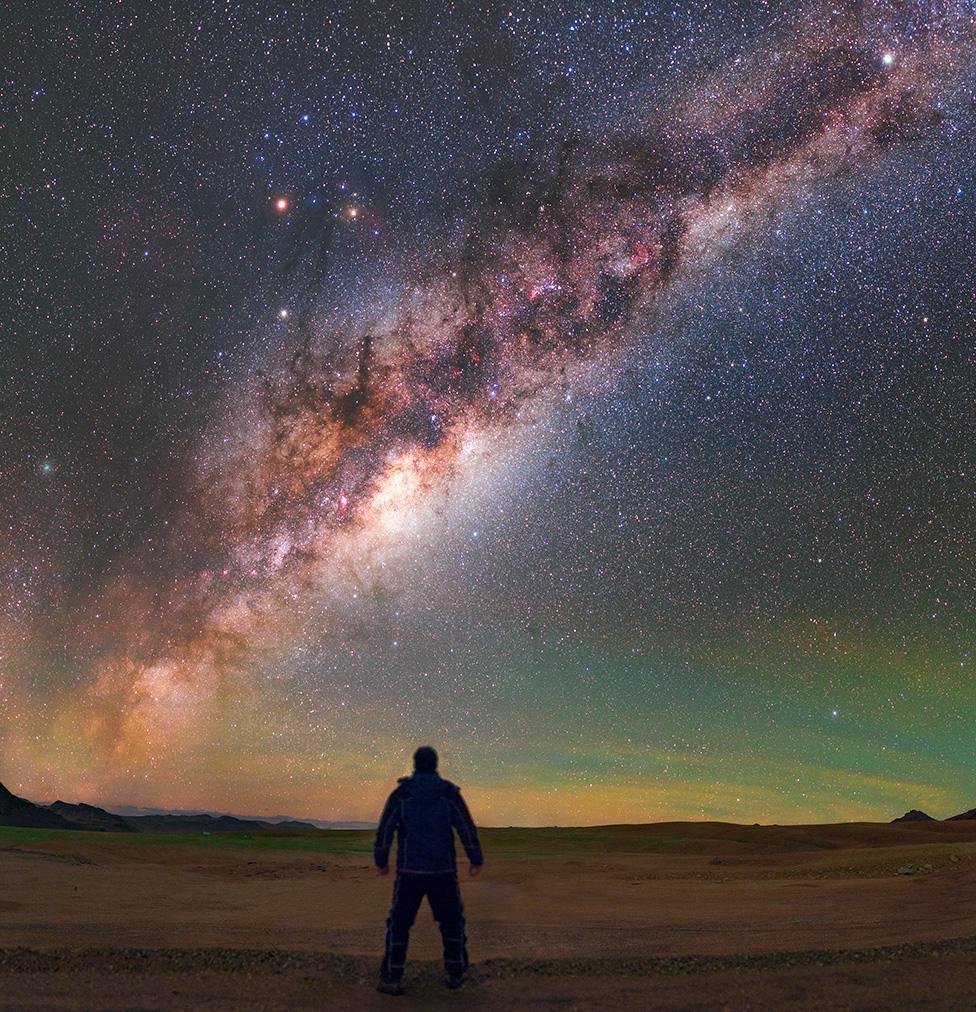
Darkness. Total and complete. Few of us get to experience it.
At the bottom of a cave, perhaps; or in a basement when the power shuts off. But there's usually some faint glow coming from somewhere. Even the night sky never seems truly black, not least because there's usually a star or two twinkling in the distance.
So it's hard to imagine a time when all that existed was darkness, when you could travel in any direction for millions of years and still see absolutely nothing.
But this is the story that scientists tell us, of the "dark ages" that gripped the Universe before the first stars ignited. And very shortly, they intend to show us that time, or rather how it ended - how the cosmos ultimately became filled with light.
They'll do it using the biggest telescope ever placed beyond the Earth: The James Webb Space Telescope, external.
Launching in the coming days, JWST is on a mission to look deeper into the Universe - and therefore further back in time - than even the legendary Hubble Space Telescope, which it succeeds.

Simply mesmerising: Webb's huge mirror is made from beryllium coated in gold
Equipped with a 6.5m-wide (21ft) mirror and four super-sensitive instruments, Webb will stare for days at a very narrow spot on the sky to detect light that has been travelling through the immensity of space for more than 13.5 billion years.
"They will be just little red specks," says JWST senior project scientist and Nobel Prize winner John Mather.
"We think there should be stars, or galaxies, or black holes maybe beginning at 100 million years after the Big Bang. There won't be many of them to find at that time but the Webb telescope can see them if they're there, and we're lucky," the US space agency (Nasa) researcher tells a special edition of Discovery on the BBC World Service.
It's an astounding idea that you might still be able to witness such a thing. But that's the consequence of light having a finite speed in a vast and expanding cosmos. If you keep probing deeper and deeper, you should eventually get to retrieve the light from the pioneer stars as they group together into the first galaxies.
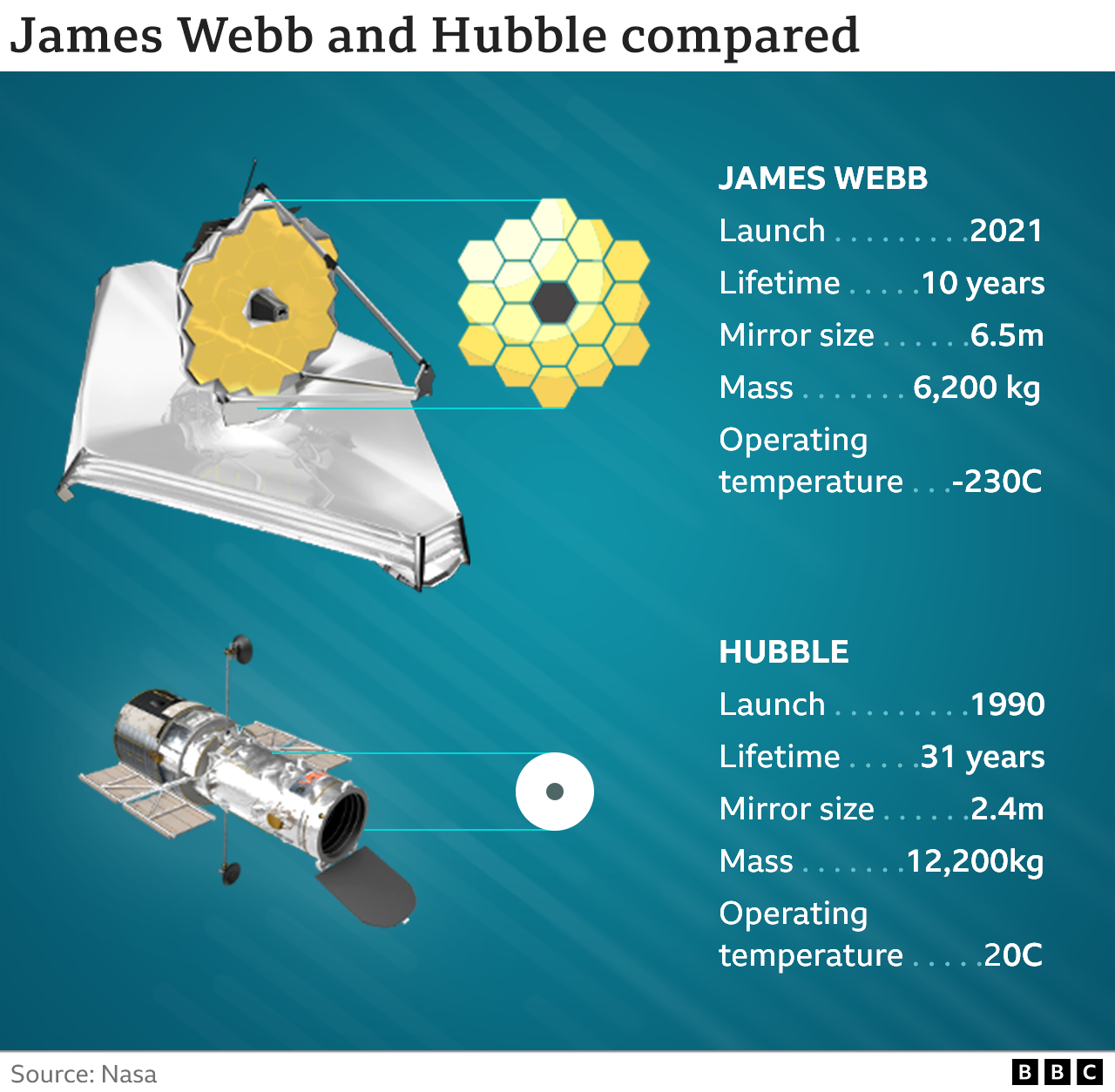
For what purpose, though? Why spend 10 years conceiving, and another 20 years building, a $10bn machine to detect some faint, red blobs on the sky?
Well, essentially it comes down to the most fundamental of questions: Where do we come from?
When the Universe was formed in the Big Bang, it contained only hydrogen, helium and a smattering of lithium. Nothing else.
All the chemical elements in the Periodic Table heavier than these three had to be forged in stars. All the carbon that makes up living things; all the nitrogen in Earth's atmosphere; all the silicon in rocks - all these atoms had to be "manufactured" in the nuclear reactions that make stars shine, and in the mighty explosions that end their existence.
We're only here because the first stars and their descendants seeded the Universe with the material to make stuff.


"Webb's mission is about the formation of all likeness; it's the 'we're all made of stardust' argument," ponders Rebecca Bowler, a University of Oxford astronomer who's a team-member on Webb's NIRSpec instrument.
"It's about the formation of the first carbon atom ever. It's absolutely amazing to me that we could actually observe that process in progress."
We don't know much about the first stars. We can put the laws of physics into computer models and run them to get a sense of what might be possible. And it sounds fantastical.
"Estimates range from anywhere of order 100 to 1,000 times the mass of our Sun," says Marcia Rieke, the principal investigator on Webb's NIRCam instrument. "And, in fact, all stars follow the rule that the length of time they can exist as a star is inversely proportional to their mass - meaning, the more massive a star, the faster it uses up its fuel. And so these early stars might have only lasted at most a million years or so."
Live fast, die young. Our own Sun seems so timid in comparison. It's already burned for nearly five billion years and will probably keep on burning for another five.
Hubble took us on an incredible journey into the past
The emphasis on the search for the first starlight makes Webb sound like a "one note flute". It's actually anything but.
It'll observe just about everything there is to see out there beyond Earth - from the icy moons and comets in our own Solar System to the colossal black holes that seem to reside at the core of all galaxies. It should be particularly adept at studying planets around other suns.
Webb has, however, been tuned to look at all its targets in a very particular way... in the infrared.
Hubble was designed to be sensitive to light predominantly at optical, or visible, wavelengths. That's the same type of light we detect with our eyes.
Webb, on the other hand, is set up specifically to detect longer wavelengths, which, although invisible to our eyes, are exactly in the regime where the glow from the most distant objects in the Universe will show up.
"Distant starlight gets stretched by the expansion of the Universe and shifts into the infrared region of the spectrum. We call it redshift," explains Richard Ellis, a University College London astronomer who's impatient to explore the end of the dark ages.
"The limiting factor we have with Hubble, for example, is that it doesn't reach far enough into the infrared to detect the starlight signal we want. It's also not a particularly large telescope. It's been a pioneering facility, for sure. Amazing pictures. But the diameter of its mirror is only 2.4m, and the power of a telescope scales with the square of the diameter of the mirror. And that's where JWST comes in."
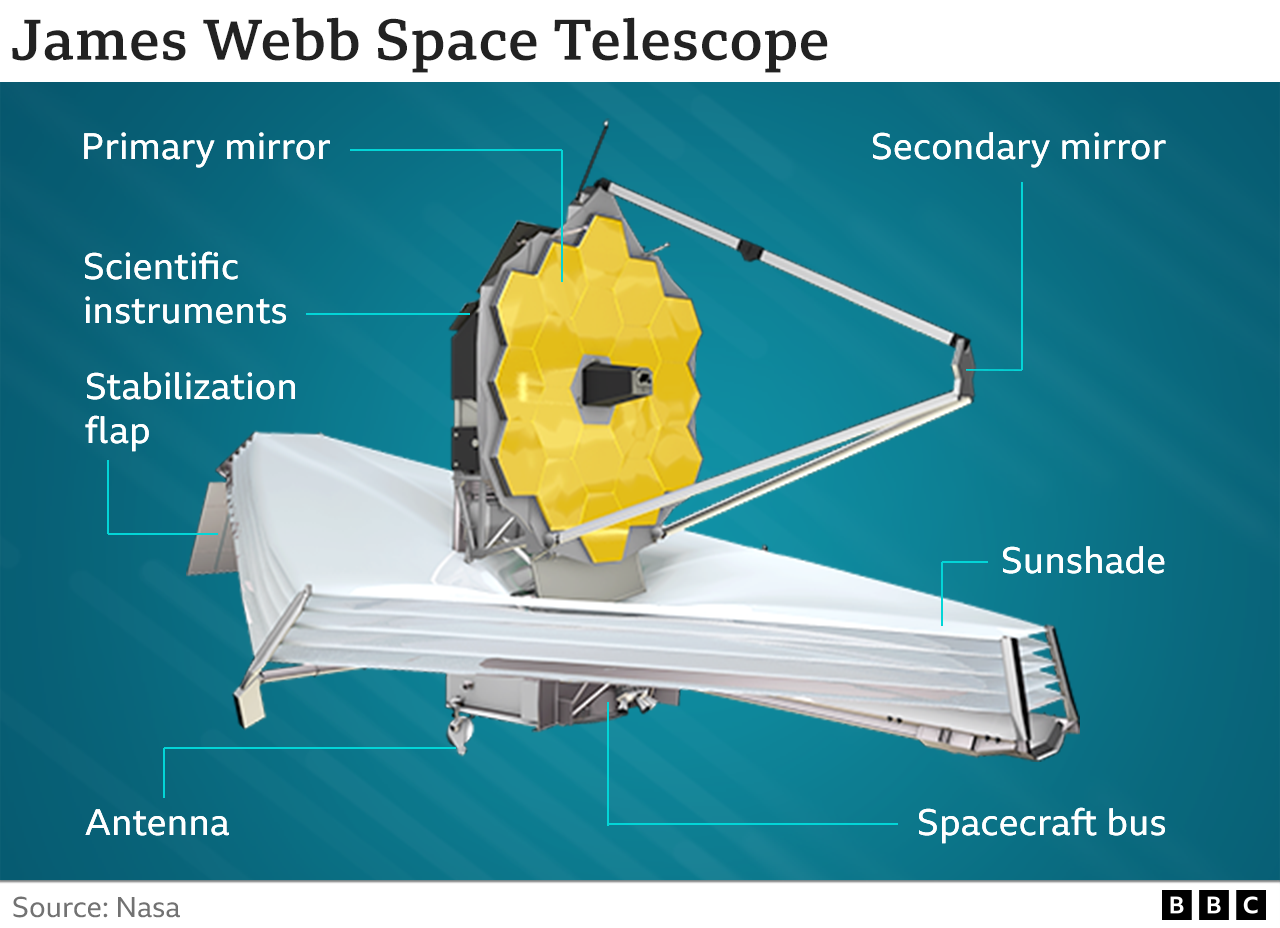

It was the 18th-Century astronomer William Herschel who discovered the infrared. He also revolutionised the production of telescope mirrors.
His hand-cranked polishing machines could achieve a super-smooth reflecting surface on a disc cast from an alloy of tin and copper.
Herschel would have appreciated the innovation that went into producing Webb's mirrors.
They're made from the metal beryllium, which is light-weight and holds its shape at very low temperatures. And then there's the gold coating. It's extremely thin, just a few hundred atoms thick, but this addition turns the mirrors into near-perfect reflectors in the infrared.
Ninety-eight percent of incident light is bounced back, ensuring the emission from distant stars experiences minimal loses by the time it reaches Webb's instruments.


Anyone who's seen the telescope's segmented 6.5m primary mirror will attest to its mesmerising quality. Even those who've worked on it for two decades never tire of its beauty.
"There was a time when the mirror was pointed downwards and I had to climb under it to do an inspection of the aft optics," recalls Nasa's Lee Feinberg, who's led the Webb mirror team.
"So, there I was in my bunny suit, looking up at all those gold surfaces and seeing myself being reflected back. It was really quite amazing - all these surfaces focusing back on me. I had this incredible feeling of energy being at the centre of it all."
Hubble famously had a major problem with its primary mirror.
When the telescope arrived in orbit in 1990, scientists realised the reflector hadn't been polished correctly. Its initial pictures of galaxies were blurred.
It wasn't until astronauts could take up some corrective optics that Hubble started to see the cosmos with clarity. And perhaps not unreasonably, it's because of that experience that everyone asks whether Webb's mirror can be guaranteed to be flawless.
Your device may not support this visualisation
August 2017 was the month that saw Hurricane Harvey stall over Texas, dumping a staggering 127 billion tonnes of rainwater on the state.
It's noteworthy because in the midst of that deluge, Webb was actually "in town", in Houston, at Nasa's Johnson Space Center, undergoing critical testing that would prove its optics were fit to fly.
Engineers had put the telescope in the space simulator that was used in the 1960s to run the rule over Apollo hardware, and even space-suited astronauts.
Chamber A, as the vacuum vessel is known, is gargantuan in volume, and was able to swallow the telescope whole (minus its sunshield). The purpose of the three-month test was to take Webb down to its operating space temperature of just below -233C (40 kelvin), to see if all its mirrors would focus as designed.
It would also give the teams working on Webb's four instruments the chance to see how their systems performed in mock off-world conditions. Assuming, that is, Hurricane Harvey would oblige.
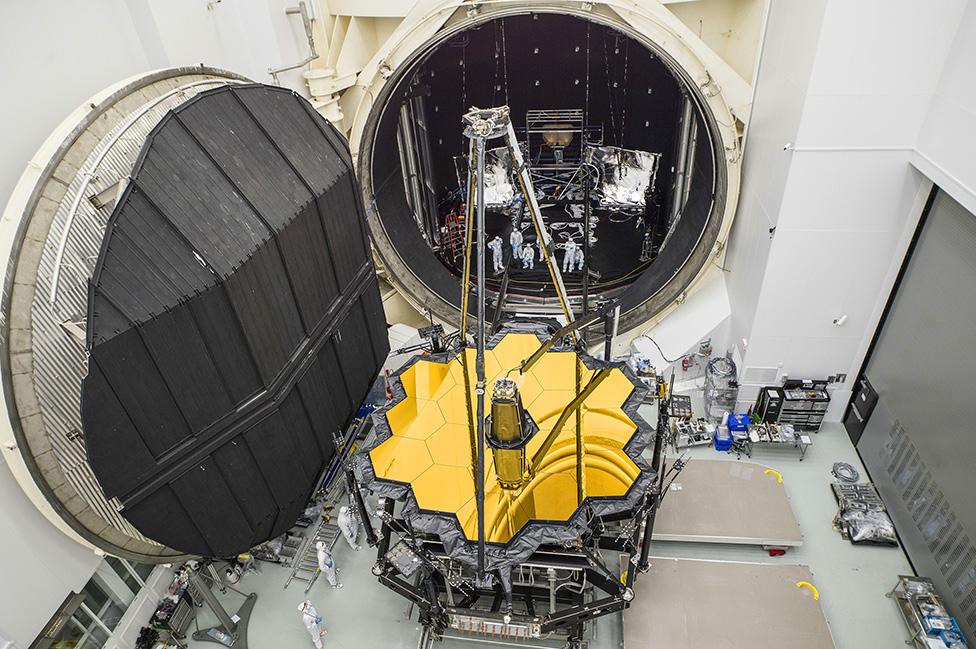
The Apollo chamber gave Webb a taste of what it will be like to operate in space
At times, the computer consoles talking to Webb inside Chamber A had to be covered in plastic sheeting to protect them from the risk of water dripping from the ceiling. But tucked away behind the thick walls of the vacuum vessel, Webb itself was secure and demonstrating it didn't have a "Hubble problem".
"The segments on the primary mirror have actuators behind them that allow us to move them around, to even change their curvature," explains Lee Feinberg. "When first deployed in space, those segments will be misaligned. But all those actuators will take us from a misalignment measured in millimetres, all the way down to just nanometres. A factor of a million improvement."
Those actuators will make the 18 segments behave as though they're a single, monolithic mirror.
Nasa instrument systems engineer Begoña Vila adds: "This is what we demonstrated in the test chamber. We know when we first focus on a star in space, we'll actually see 18 different spots of light because the 18 individual mirror segments won't be aligned. But then we'll adjust the mirrors to bring all the spots together to make a single star that's not aberrated and good for normal operations. We know Webb works."
Gillian Wright: "The technologies on James Webb took years to develop"
Gillian Wright is carrying a Tupperware box.
"This isn't any old Tupperware; it's space-qualified Tupperware. It meets all the international standards for keeping things flawlessly clean for years," the UK Astronomy Technology Centre director says.
If you want to understand just how brilliant Webb is, but also why it's taken so long to build - some 20 years in the construction phase - you need to look in Gillian's plastic box.
It contains a spare "slicing mirror" from the Mid-Infrared Instrument (MIRI) that she and colleagues have built for the telescope.
About the size of a British 50-pence piece, it looks like a mini musical accordion made for a doll. The little mirror - once again coated in gold - contains a series of slanted "steps".
The arrangement allows the mirror to acquire both an image of the sky but also to chop up the light from, say, a galaxy or the edge of a black hole, and then send that light into a spectrograph. This device will reveal the chemistry, temperature, density and velocity of the targets under study.
"But not just at one point in the image, but at every point across the image, all at the same time. You go from 2D to 3D - to what we call a data cube," she tells me.
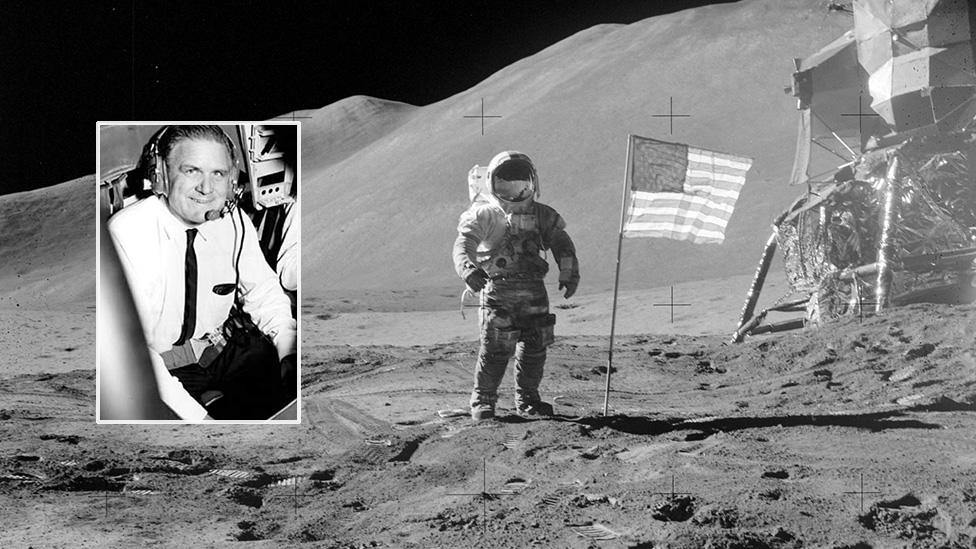
James E Webb was a key figure at Nasa tasked with implementing the Apollo Moon-landings project
This had been done in ground-based astronomy, but was novel for Webb. What's more the level of engineering precision required was extremely challenging. The steps had to be very carefully machined so that they had supremely sharp edges, otherwise light of different wavelengths would bleed across the mirror, contaminating the data.
It took a year to convince the space agencies that MIRI's slicing mirrors would meet the specifications. And here's the thing: this is but one small component in one part of a giant telescope.
When they assembled Webb, every such element had to be tested and then tested again when joined to another element. The whole edifice was built up like a Russian doll.
Former Nasa project scientist Mark Clampin explains: "Because it's such a big and complex observatory, and also because it has to work at cryogenic temperatures, you can't just put everything together at once, and then test it. You put everything into sealed, thermally isolated packages, starting with the smallest pieces and working upwards, testing at every stage. And then as everything gets bigger and bigger, it becomes virtually impossible to go back because you found a problem in a detector, let's say."
Imagine towards the end of the telescope's construction they realised one of MIRI's slicing mirrors was defective.
Disassembling the multi-billion-dollar observatory to get at the sub-standard part would be the nightmare of all nightmares.

James Webb is so big it has to be folded to fit in the nosecone of its launch rocket
Mark McCaughrean is a British infrared astronomer who's worked on the project for 23 years in an advisory capacity for the European Space Agency. He's seen bits and pieces of Webb before, but just weeks before the expected launch, from the Kourou spaceport in French Guiana, he's getting the chance to examine the completed observatory for the first time.
"I have no idea what to say. It's astonishing." There's emotion in his voice.
The mirrors and insulation blankets are a blaze of gold and silver. The latter colour has a slight purple tinge to it. We're viewing Webb in its folded configuration, but still it's the size of a single decker bus.
This "bus" has been upended to fit snuggly in the nosecone of its Ariane launch rocket.
"It has an amazing scale to it," comments Mark. "When it unfolds in space - a bird flying freely in space - wouldn't that be a thing to see!"
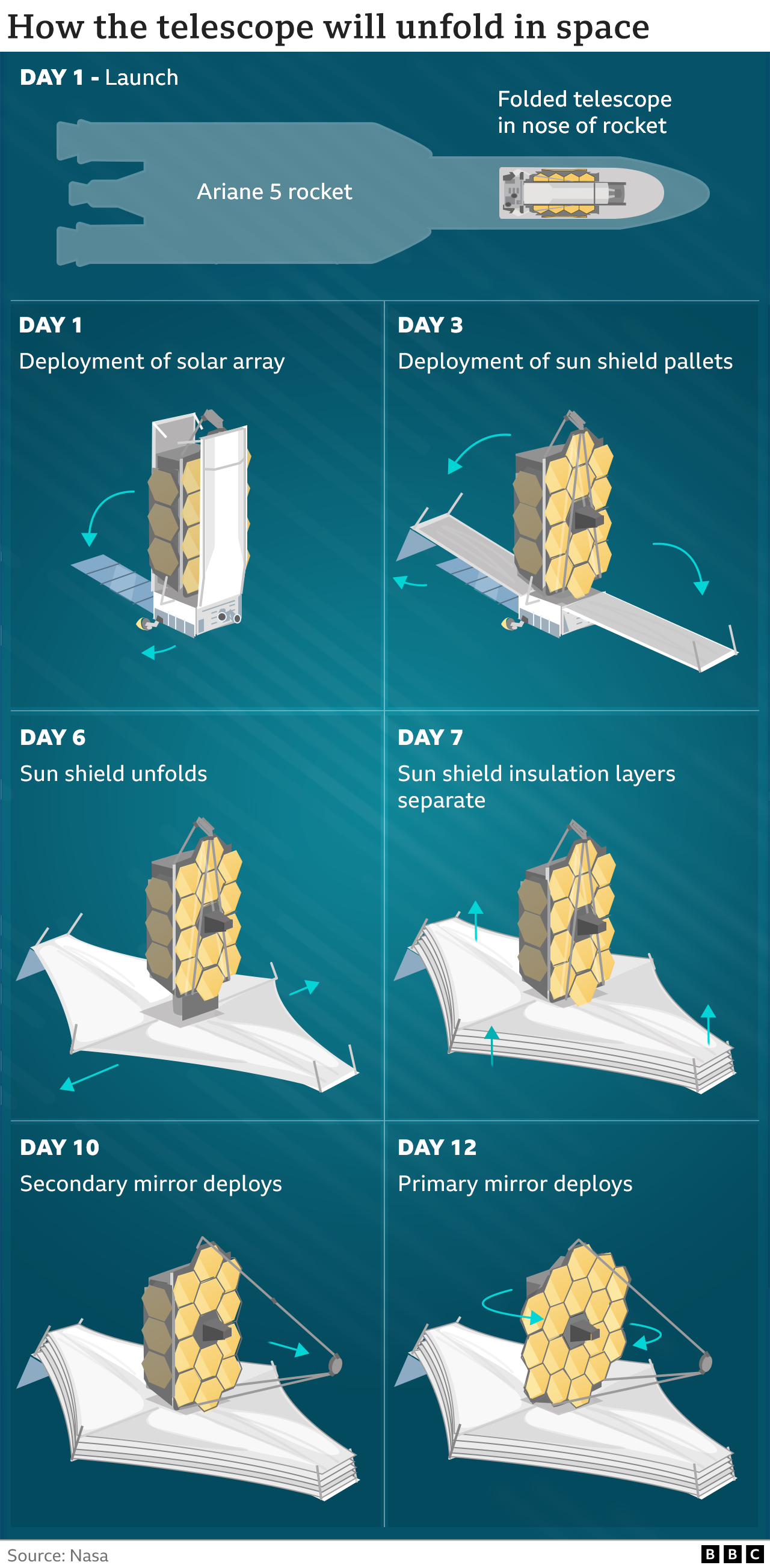

Webb has had to battle the naysayers all through its development. "It's too complex," they would say. And when you consider the sequence of deployments the telescope must complete in order to begin its observations of the cosmos, it is kind of scary.
Engineers refer to "single point failures" to describe the actions, which, if they don't occur on cue and in the right order, are likely to scupper the whole undertaking. Webb must get past 344 of these decisive hurdles.
Some actions should be very straightforward, such as the deployment of a solar panel and radio antenna in the minutes immediately after launch.
Even the opening of the wings of the primary mirror ought to be regarded as a fairly standard operation. But the actions concentrated around the unfurling of the tennis court-sized shield that will keep Webb cool and protect its vision from the glare of the Sun - that's another matter.
"Some of the key hardware includes 140 release mechanisms, about 70 hinge assemblies, eight deployment motors; we have bearings, springs, gears; about 400 pulleys are needed and 90 cables, totalling 1,312ft (400m)," says Krystal Puga from aerospace manufacturer Northrop Grumman.
"To perfect the sequence, we performed multiple deployment testing over several years on both small and full-size models. We practised not only the deployment but also the stowing process. This gives us the confidence that Webb is going to deploy successfully."
Amber Straughn, an astrophysicist on Nasa's JWST science team, explains why the telescope is so exciting and important
For those of us who haven't been directly involved in the project, the whole unfolding process looks terrifying. What if one of the cords pulling on the super-thin membranes snags, or, worse still, snaps?
John Mather is the calming voice. His many years on the Webb venture have led him to a philosophical position.
"I'm confident," he says, "and yet, I'm also aware that no matter how good a plan we have - and we have a very good plan - bad things can still happen. But my opinion has no effect on the hardware. And, consequently, my worrying also has no effect on the hardware. So I mostly don't worry."

Given all that Hubble has shown us, the old telescope now looks like a very solid investment
I've left the topic until last, but it cannot pass without some comment. The cost.
The figure everyone quotes is $10bn (£7.5bn; €9bn). It covers the direct 20-year build period, the launch and five years of operations in space.
As a cold number, it is eye-watering. But it's worth remembering that Hubble was also very expensive. The legendary observatory had cost more than $7bn in 2021 dollars by the time it had been launched and repaired. It must be nearer twice that now.
But given all that Hubble has shown us about the Universe, and our place in it, the old telescope seems good value.
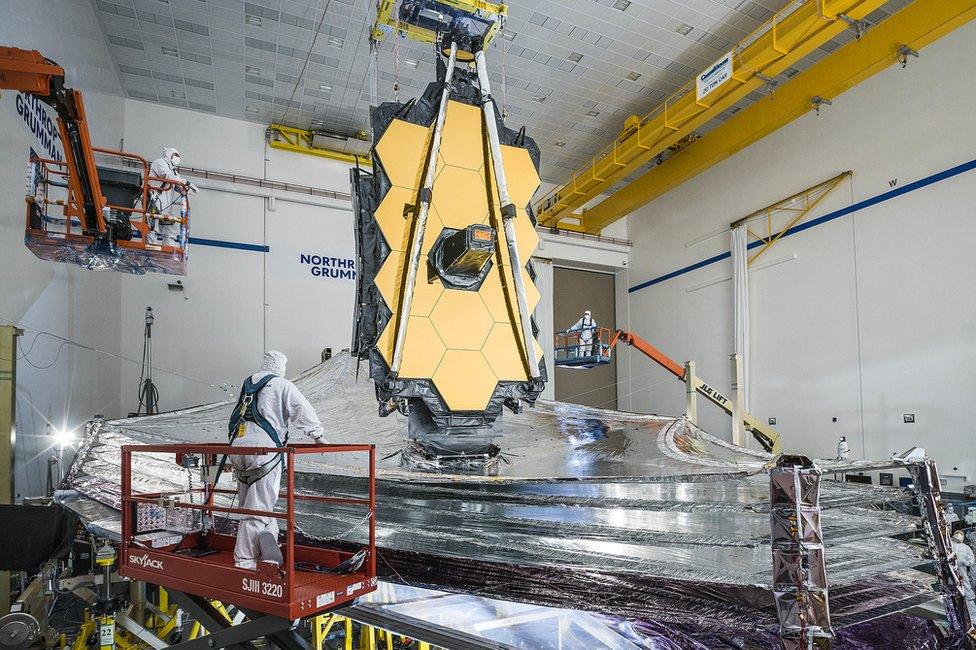
For Europeans, the cost of Webb has amounted to the price of a cheap cup of coffee
If Webb succeeds in showing us our atomic origins, who will continue to quibble about cost?
"On face value there's a lot of zeroes, and Europe alone has spent €700m (£600m; $800m) on James Webb," says former European Space Agency project manager Peter Jensen.
"But when you look at it as a cost per inhabitant in Europe, it comes down to a cheap cup of coffee in a cheap café, drunk over a period of 20 years."
You can hear Jonathan talking to key figures on the James Webb mission in a special edition of Discovery on the BBC World Service and on Inside Science on BBC Radio 4.